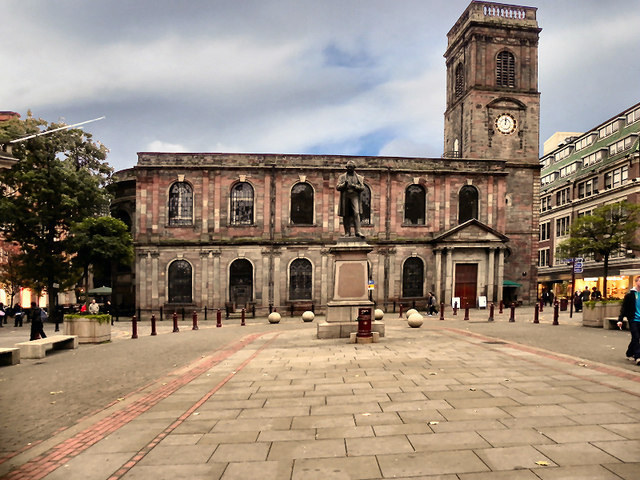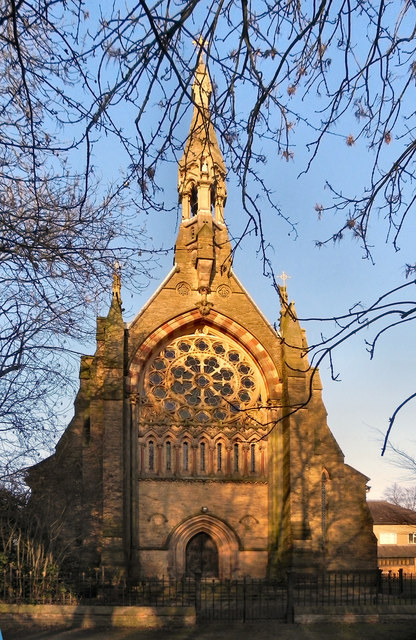Stand Church
More commonly known as All Saints' Church, this active religious edifice is situated in the town of Bury. Its construction started in 1821 and ended five years later in 1826. It was designed by Charles Barry in the Gothic Revival style and is one of the tallest churches in the county. The altar, pulpit and screen however are much younger as they date back to the early 1920s. Most of the interior features were designed by Lancaster architects Austin and Paley. In 1966, Stand Church became part of the National Heritage List for England and was recognised as a Grade I edifice.

St. Ann's Church
Located in the city of Manchester, St. Ann's Church is one of the oldest religious buildings in the county. It was built during the early years of the 18th century and given the fact that at the time Manchester was a small rural town it really stood out and became one of the symbols of the settlement. The structure is named after St. Anne but also commemorates its patron, Ann, Lady Bland. The edifice was designed in the neo-classical style by the legendary English architect Christopher Wren and its tower was specifically built to mark the centre of Manchester. It has a two-leveled interior and is situated on St. Ann's Square which is one of the city's most renowned and visited landmarks. St. Ann's Church is currently one of the three local religious buildings to be listed as Grade I edifices, the other two being:
Edgar Wood Centre which is an non-active church that was established in 1903
Church of the Holy Name of Jesus which was designed by Joseph Hansom and built from 1869 to 1928

Oldham Parish Church
Officially known as the Oldham Parish Church of St. Mary with St. Peter this breathtaking religious building was opened in 1830 and sits on the same site were stood a 13th century church. It was designed by Manchester-based architect Richard Lane in the Gothic Revival Style and is currently one of the churches that form the Diocese of Manchester. On the 23rd of January, 1973, it was recognised as a Grade II* building. The church is also one of Oldam's most popular touristy attractions and tends to attract both local and foreign visitors.

Church of St. Leonard
Most of the church was built by Thomas Langley in 1412, who reused the Norman doorway from a previous structure to create the church's tower arch. The edifice however was fully completed over a century later by Sir Richard Assheton. The most unique feature of the building is its Flodden Window which is credited to be the oldest war memorial in the United Kingdom. The church's tower is topped with a wooden belfry which is quite common in northern England. It also houses one of the finest collections of monumental brasses in the county including the only brass in the country that depicts Major-General Sir Ralph Assheton in full armour during the events of the English Civil War. During the late 1950s the Church of St. Leonard was listed as a Grade I building by the English authorities.

Church of St. Martin
The Metropolitan Borough of Stockport is home to several well-known buildings and religious structures. One of these edifices is the Church of St. Martin which was designed by J.D. Sedding and built in 1870. The north chapel and aisle however weren't part of the original building. They were added during the mid-1890s and early 1900s by H. Wilson. It is currently the only religious edifice in the borough to be listed as a Grade II* building. The stained glass windows of the church were designed by:
Artist and painter Edward Burne-Jones
Poet, illustrator and painter Dante Gabriel Rossetti
Textile designer, poet and novelist William Morris
Painter Ford Madox Brown

Church of St. Mary the Virgin
Built during the 13th century, this church was at the time the centre of a large ecclesiastical parish. The building is constructed with red ashlar sandstone and has slate roofs. During the 14th, 15th and 16th centuries the edifice was the subject of several expansion and reconstruction projects. The latest structural alteration was conducted in 1862 by J.P. Holden. The church's main feature is the Entry to Jerusalem Window which was created in Rouen, France during the 16th century and mounted in St. John's Church in the city of Manchester. After the church was demolished the window was installed in at its current place. The structure has been listed as a Grade I building since the mid-1960s.
All Saints' Church
This Roman Catholic Church is situated in the town of Urmston in the Metropolitan Borough of Trafford. The construction of the structure began in 1867 and ended in 1868. The church is designed by E.W. Pugin in the Gothic Revival Style and was commissioned by Sir Humphrey de Trafford. The building has a stone carved alter and displays a painting of E.W. Pugin holding the blueprinting of the church. All Saints' Church along with the Old Church of St. Werburg are the only two religious edifices in the borough to be listed as Grade I buildings.

St. Lawrence's Church
Historians believe that this church dates back to the first half of the 16th century. At the moment it is one of the 29 surviving timber framed religious buildings in England. At first the structure was dedicated to St. James, but in 1839 it was rededicated to St. Lawrence and became a parish church. During the early 1870s J. Medland and Henry Taylor were appointed to organise and supervise the edifice's expansion and reconstruction project. From 1993 to 2003 the church was the subject of a major restoration project which was fully funded by Tameside MBC. It is listed as a Grade II* structure.


